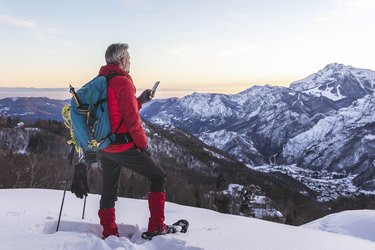
Don't let dropping temperatures confine your workouts to your house. Skiing, snowboarding and even shoveling snow present new ways to burn calories this winter. Plus, when you layer up and head outside, you get to breathe fresh air and potentially soak up vitamin D from the sunshine.
However, if you're not used to exercising in freezing temperatures, the hazards of winter weather can sneak up on you. Wear layers so you can peel off as clothing gets wet or your body temperature starts to rise, says Chris Gagliardi, a medical exercise specialist certified by the American Council on Exercise (ACE).
Video of the Day
Video of the Day
"Select clothing materials that give off heat during exercise and retain heat during inactive periods like wool and synthetic materials," he tells LIVESTRONG.com.
And of course, as with all types of exercise, remember to stay hydrated.
Grab a parka, a cap and some gloves and try one (or all) of these activities to stay active all winter.
For each activity, the estimated calories burned are based on calculations from ACE Fitness using body weights of 125/150/225 pounds and assuming an hour of moderate-intensity activity.
A Quick Note About Counting Calories
As long as you’re moving your body regularly, you can be sure you’re making the right choices for your health. Obsessing over calories isn't the only way to stay in shape, and it may lead to an unhealthy relationship with exercise.
1. Downhill Skiing
Hitting the ski slopes is often the first thing that comes to mind when people think of winter activities. An adult skiing downhill at a casual pace for an hour will burn between 250 and 510 calories. Increase your speed just a bit to a moderate pace and you can burn 100 calories more per hour. Downhill skiing is also great for muscle-strengthening; it works your legs, core and arm muscles.
Of course, what goes down must come up first. When calculating your time on the slopes, subtract the time you spend on the lift and in line to factor in only the amount of time you're actually skiing.
Calories Burned: 340/408/612
2. Snowboarding
Snowboarders and skiers have been at odds since the two downhill sports started competing for run-time on the slopes. When it comes to calorie burn, though, moderate snowboarding inches out ahead of moderate-speed skiing — but not by a lot.
The big difference is in the muscle groups used. Both require strong legs and ankles and a solid core for balance, but boarding requires increased flexibility and slightly more core strength to support body rotation.
"To further increase your calorie burn, stretch before hitting the slopes with leg lifts and other lower-body strength exercises like squats or racing up the stairs," Caleb Backe, personal trainer and health expert at Maple Holistics, tells LIVESTRONG.com.
Calories Burned: 357/428/642
3. Cross-Country Skiing
"Cross-country skiing might be the best winter workout activity as it's a total-body workout," says Alan Snyder, DPT, of Breakaway Physical Therapy. It hits all your major muscle groups, including triceps, biceps, upper and lower back, abdominals, obliques, glutes, hip abductors, quadriceps, hamstrings and calves.
To increase the calorie burn, Snyder recommends adding a HIIT component to your workout, increasing your speed for short periods of time followed by equal or shorter recovery periods. Or since cross-country skiing is all about using energy to propel your own body weight, add resistance by wearing a weighted vest or tote a toddler along on a sled.
Calories Burned: 453/544/816
4. Snowshoeing
Snowshoeing is a fantastic exercise that requires little no experience to get started, as long as you can walk. A moderate pace of 3 miles per hour gives you a great lower-body workout that targets your glutes, calves, hip abductors, quads and hamstrings. Snyder suggests finding a terrain that includes small hills like a golf course for an additional cardio boost.
Calories Burned: 453/544/816
5. Ice Skating
Indoors or outdoors, ice skating can be fun for the whole family or make for a romantic date. On a smaller rink, simply keeping your balance and staying out of other skaters' way can present its own set of challenges, while burning a decent amount of calories.
Maintaining your balance as you skate engages your core and lower body in a slightly different way than walking and running, so don't be surprised if you're a bit sore the next day. It also builds your ankle strength — an area that is often forgotten. On a less-crowded, larger rink, you can get your speed up and really boost the burn, or try varying your speed and duration with sprints and recovery laps.
Calories Burned: 396/476/714
6. Sledding
Embrace your inner child, grab a sled and head to your nearest hill. One hour of sledding burns around 400 calories, assuming you're walking uphill and not catching a lift.
"To bump up the calorie burn, select steeper hills, so the walk back up will require extra effort from your leg muscles, and offer to carry two sleds at a time," Backe says. Or add a little healthy competition with friends and race up or down to increase the burn — and the fun.
Calories Burned: 396/476/714
7. Shoveling Snow
You may think you're just cleaning off your driveway or digging out your car, but you might be surprised to learn that shoveling snow is quite a workout, Backe says.
To burn even more calories, speed up your shoveling time and take shorter rests. When snow is deeper, heavier, wetter, denser or icier, it weighs more than the light, fluffy, new-fallen stuff. The harder it is to lift and deposit, the more calories you burn.
Calories Burned: 340/408/612
Was this article helpful?
150 Characters Max
0/150
Thank you for sharing!
Thank you for your feedback!